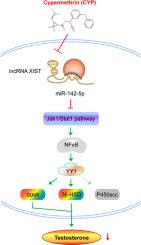Ecotoxicology and Environmental Safety ( IF 6.2 ) Pub Date : 2021-09-17 , DOI: 10.1016/j.ecoenv.2021.112792 Changjiang Liu 1 , Jiayuan Qu 2 , Mingzhu Wu 3 , Xu Huang 2 , Lianbing Li 2

|
Cypermethrin (CYP), an extensively-used broad-spectrum pyrethroid pesticide, is regarded as a potential environmental endocrine disruptor with the anti-androgenic characteristic. To explore underlying roles of non-coding RNAs and the Jak/Stat pathway in CYP-mediated testosterone biosynthesis suppression, SD rats and Leydig cells were employed in this work. Results displayed that β-CYP decreased plasma testosterone levels and led to abnormal alterations of testicular histomorphology and ultrastructures. LncRNA XIST and miR-142–5p were co-localized in the cytoplasm of Leydig cells, but the expression of XIST was inhibited by β-CYP while that of miR-142–5p was induced. Then overexpressed miR-142–5p dampened the Jak1/Stat1 pathway by directly targeting Jak1. Transcription factors NFκB and YY1 impeded by β-CYP were positively regulated by the Jak1/Stat1 pathway. Bidirectional Co-IP and ChIP assays demonstrated that NFκB interacted with and modulated YY1 by directly binding to the promoter region of YY1. ChIP, qPCR, and YY1 knockdown/overexpression assays indicated that YY1 acted as a transcriptional activator to directly modulate steroidogenic StAR and 3β-HSD in Leydig cells. Taken together, miR-142–5p sponged by lncRNA XIST directly targets the Jak1/Stat1 pathway, which regulates steroidogenic StAR and 3β-HSD via NFκB and YY1, and ultimately dampens testosterone production in Leydig cells.
中文翻译:

氯氰菊酯触发 YY1 介导的睾酮生物合成抑制
氯氰菊酯(CYP)是一种广泛使用的广谱拟除虫菊酯类农药,被认为是一种潜在的具有抗雄激素特性的环境内分泌干扰物。为了探索非编码 RNA 和 Jak/Stat 通路在 CYP 介导的睾酮生物合成抑制中的潜在作用,本工作使用了 SD 大鼠和 Leydig 细胞。结果表明,β-CYP 降低血浆睾酮水平并导致睾丸组织形态学和超微结构的异常改变。LncRNA XIST 和 miR-142-5p 共定位于 Leydig 细胞的细胞质中,但 XIST 的表达被 β-CYP 抑制,而 miR-142-5p 的表达被诱导。然后过表达的 miR-142-5p 通过直接靶向 Jak1 抑制了 Jak1/Stat1 通路。受 β-CYP 阻碍的转录因子 NFκB 和 YY1 受到 Jak1/Stat1 通路的正向调节。双向 Co-IP 和 ChIP 测定表明,NFκB 通过直接结合 YY1 的启动子区域与 YY1 相互作用并对其进行调节。ChIP、qPCR 和 YY1 敲低/过表达测定表明 YY1 作为转录激活因子直接调节 Leydig 细胞中的类固醇生成性 StarR 和 3β-HSD。总之,被 lncRNA XIST 吸收的 miR-142–5p 直接靶向 Jak1/Stat1 通路,该通路通过 NFκB 和 YY1 调节类固醇生成性 StAR 和 3β-HSD,并最终抑制睾丸间质细胞中睾酮的产生。和 YY1 敲低/过表达测定表明 YY1 作为转录激活剂直接调节 Leydig 细胞中的类固醇生成性 StAR 和 3β-HSD。总之,被 lncRNA XIST 吸收的 miR-142–5p 直接靶向 Jak1/Stat1 通路,该通路通过 NFκB 和 YY1 调节类固醇生成性 StAR 和 3β-HSD,并最终抑制睾丸间质细胞中睾酮的产生。和 YY1 敲低/过表达测定表明 YY1 作为转录激活剂直接调节 Leydig 细胞中的类固醇生成性 StAR 和 3β-HSD。总之,被 lncRNA XIST 吸收的 miR-142–5p 直接靶向 Jak1/Stat1 通路,该通路通过 NFκB 和 YY1 调节类固醇生成性 StAR 和 3β-HSD,并最终抑制睾丸间质细胞中睾酮的产生。











































 京公网安备 11010802027423号
京公网安备 11010802027423号